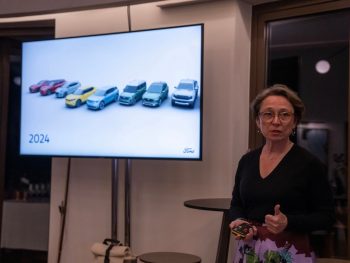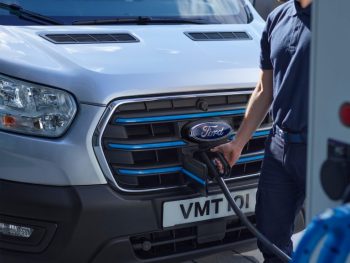Ford of Britain chief Lisa Brankin has intensified industry calls for fresh electric vehicle incentives and a rethink on the ZEV mandate structure, warning that targets are at risk without new ways to drive demand.

Speaking at an exclusive roundtable event at the launch of the new Explorer electric SUV in the New Forest, Brankin stressed that current demand for EVs is not enough to meet mandate targets and the Government must introduce a “bold demand solution” to drive EV uptake on the private consumer side and for electric vans.
The Ford boss also emphasised that the Vehicle Emissions Trading Schemes (VETS) Order 2023, which encompasses the ZEV mandate, needs a reset.
Brankin, who joined Ford in 1990 as a graduate trainee and was appointed MD for Ford of Britain and Ireland in 2020, said the brand was seeing an exciting future thanks to its completely new commercial vehicle line-up and the rollout of its new passenger vehicles with Explorer here already, Capri later this year and Puma Gen-E due early 2025.
But she continued: “The number one thing that I’m thinking about at the minute is VETS compliance. So that’s probably one of the biggest challenges that we’re grappling with as an industry, as a manufacturer.
“The UK government has set really, really ambitious CO2 targets. They want to deliver almost a 70% reduction in CO2 by 2030, and because transport is one of the biggest contributors to CO2, and we need to play our part in delivering that objective hence the VETS trajectory. And if we want to get to that target of CO2, then we’ve got to deliver the VETS part. Unfortunately, at the minute we’re not, as an industry, on track to do that, and that’s driven really by not seeing customer demand for electric vehicles.”
Across the new car sector, Ford said EV take-up is running at about 18%, below the industry mandate of 22% for 2024. But if you break that down into the different segments, retail demand is, year to date, below 10%. Meanwhile the fleet sector is around 36% “because there’s an incentive for drivers to choose electric,” Brankin said.
“We can’t just depend on company car drivers because the retail sector is 40% of the industry,” she added. “So if we want to make VETS a success, we need some customer incentives in the UK market.
“Our really strong core message to the UK government is, if you want to collectively get to that 2030 CO2 target, we need to do something about driving customer demand, so that’s what’s top of my mind at the moment.”
A need for stimulus to get momentum into the system
With a consultation on the shift back to a 2030 ICE phase-out expected any day and all eyes on the Autumn Budget for support measures, Brankin reiterated calls from the SMMT for the Government to temporarily halve VAT to 10% on electric vehicles, making them more affordable for UK customers.
She also restated the SMMT’s call for VAT on public charging to be dropped in line with home charging costs and for the Government to scrap the upcoming VED ‘Expensive Car Supplement’ for cars that are more than £40,000.
Brankin emphasised that any new retail incentives must be in addition to the existing structure of low Benefit-in-Kind rates for fleet drivers and the Plug-in Van Grant.
She continued: “What we know is the incentives that we’ve got at the minute are working. So walking away from that could potentially be a challenge.
“I think that the [existing] incentives need to stay in place, so we begin to get to a tipping point where businesses are comfortable, they’ve got the infrastructure, they’ve made things happen.”
Brankin also underscored that the whole industry is aligned on this.
“We need to get momentum, and we don’t have momentum. And if we all agree that the 2030 CO2 objective that the UK has signed up to is where we want to end up, we all need to get behind it, and we all need to make VETS a success. And a success is customers, retail customers or fleet customers or commercial vehicle customers, buying and running electric vehicles. That’s what success looks like.”
Ford, along with many others, has called for more flexibilities within the VETS structure.
“The whole VETS scheme is really complicated,” Ford’s MD stated.
“The one thing I will say is, if you look at the graph, the VETS graph, it’s a straight line. And I don’t think I’ve ever seen any business growth or adoption where it runs in a straight line. You know, we will have ups and downs. So it’s important that we have within that transition a degree of flexibility in terms of carbon budget. And overall, our goal is to reduce the amount of CO2 that the UK emits. So as long as we’re progressing towards that, and we’re heading there, that’s where we need to keep our eye on.
“Which is why it’s so important that, at the moment, what we’re focusing on is customer incentives, because that’s where you drive that transition. If you fixate on something else, we’re not really looking at the bigger prize. That’s what we need to look at.”
Ford’s director of government affairs, Nicola Walker added: “Without that demand, the [VETS] scheme does not work. We will have nine electric vehicles by the end of 2025 and we still won’t be able to hit that ZEV target. That demonstrates that something’s not right at the scheme. And the challenge is even more acute on the commercial vehicle side, because, of course, some of the flexibilities available to help companies meet the scheme, meet the targets, they’re not going to be possible to use in commercial vehicles.
“We are the market leader. We have the electrified product in the market. There’s no one to buy credits from on the commercial vehicle side. So it demonstrates that reform of the scheme is absolutely necessary.”

Asked whether Ford will end up paying fines, Brankin continued: “That’s not what I’m saying. I’m saying that we’re working as hard as we can to hit government targets, but without incentivisation, it’s going to be really hard for the industry overall to get to the targets, and within that, for us to get to targets as well.
“Which is why we feel really strongly that we’re asking for customer incentivisation to drive demand, to help us move customers into electric vehicles.
“I can’t really talk about everybody else, but I can talk about Ford; we’ve invested really heavily, bringing electric vehicles to market. So we have Mach-E, we have Explorer, we’ll have Puma Gen-E. We’ve got Transit Custom and a range of other electric options on commercial vehicles. We spent $2 billion in Cologne and £450m in the UK around electrification. We’re committed to electrified product in the UK market. We just need to get the customer momentum and demand to make a switch.”
While some automakers have talked about, and enacted, measures to achieve ZEV mandate targets through limiting ICE vehicles, Ford said it’s not a route it wants to go down.
Brankin affirmed: “That’s not a plan. That’s not where we want to end up. We know customers still want those vehicles, we know the network still wants to sell them, but we don’t want to restrict the supply, because at the end of each of those vehicles is a customer, and that’s what people forget in all of this. So that’s not what we want to do. But you know, that is one of the plans that might have to happen but that’s not what we’re planning for at the moment.”
Fleet World also asked Brankin about the latest on Ford’s plans for developing cheap EVs; in 2022, the brand established a ‘skunkworks’ team in California, focused on “changing the company’s approach to next-generation vehicle development and bending the cost curve on electric vehicle” and backed by talent from brands such as Tesla and Apple.
The crew was initially rumoured to be working on a small $25,000 (c.£15,300) crossover but Ford announced in August that the first affordable vehicle off this new platform will be a mid-sized electric pickup launching in 2027.
Asked if she can talk yet about Ford’s plans for a small electric car and Brankin smiled and said, “Not yet. What I will say is, we’ve got Puma Gen-E at the end of the year, which will be a really good addition to our portfolio, spreading our range from smaller to larger EVs. I think that’s a really nice add to our EV portfolio.”
Ford is also exploring options for hydrogen and is leading an innovation consortium testing hydrogen fuel cell technology on its all-electric E-Transit.
The three-year project, currently around the halfway mark, is building a test fleet of eight fuel cell Ford E-Transits, which are now starting tests.
Brankin finished off by stressing the many positives being seen in the industry at the moment but also the many challenges that the Government needs to step in and provide support with.
“It feels like at the moment, there’s a huge amount of stuff happening in our industry. Everyone really says this all the time, but at this point in time, you’ve got electrification, you’ve got connected vehicles, you’ve got more digital experiences, you’ve got everything coming together in a really fast revolution happening in a really compressed timeline.
“And there’s an opportunity that we’re encouraging the Government to grasp to help us so we’ll get to where we need to get to.”

